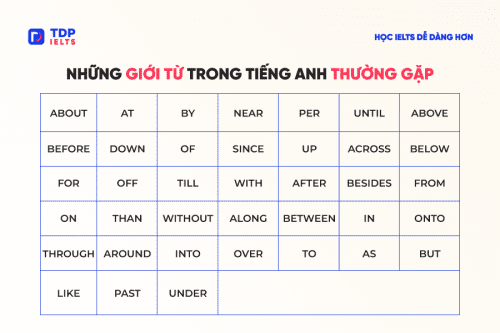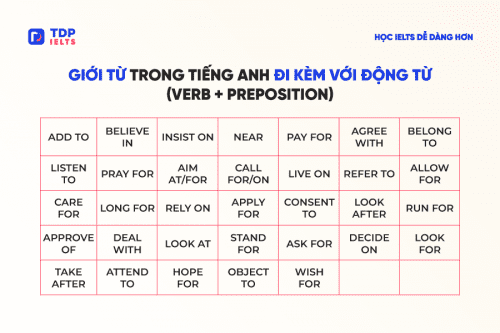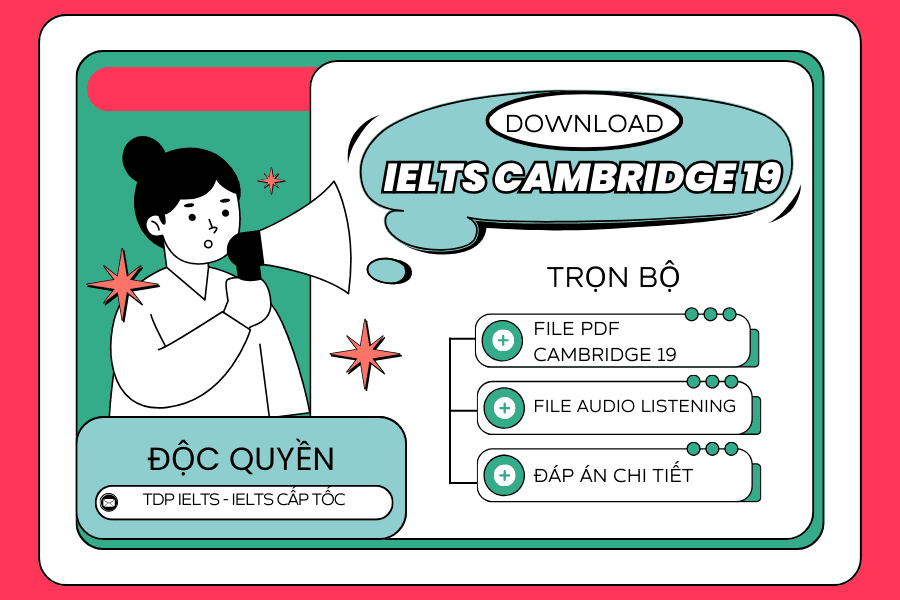Chắc hẳn ai học tiếng Anh cũng đã đều nghe qua về giới từ, nhưng để hiểu sâu hơn về nó thì khá phức tạp. Hôm nay, hãy cùng TDP IELTS tìm hiểu tất cả những gì bạn cần biết về giới từ nhé.

Xem thêm: Lộ trình học IELTS từ 0 đến 6.5 cho người mới bắt đầu
Nội dung
ToggleGiới từ trong tiếng Anh là gì?
Giới từ trong tiếng Anh là từ thường đứng trước cụm danh từ (noun phrase) hoặc đại từ (pronoun).
Ví dụ:
of the world
with my best friend
by us
at a hotel
Những giới từ trong tiếng Anh thường gặp
Dưới đây là bảng liệt kê các giới từ trong tiếng Anh thường xuyên bắt gặp trong môi trường giao tiếp hằng ngày:

Vị trí của giới từ trong tiếng Anh trong các dạng câu khác nhau
(i) Câu hỏi: Who is she working for? She is working for a friend.
(ii) Mệnh đề quan hệ: The town (that) he was born in. He was born in the town of Lascelles.
(iii) Câu cảm thán: What a terrible situation she’s in! She’s in a terrible situation!
(iv) Câu bị động: He’s being well looked after. They’re looking after him well.
(v) Câu so sánh: She’s been to more countries than I’ve been to. I’ve been to fewer countries.
(vi) Câu khẳng định: This pen is difficult to write with. It’s difficult to write with this pen.
(vii) Câu nhấn mạnh: Some games I’m quite good at. But I’m hopeless at golf.
(viii) Tính từ + giới từ: I’m not fond of tennis. She’s afraid of losing money.
Giới từ trong tiếng Anh đi kèm với động từ (verb + preposition)
Các giới từ trong tiếng Anh vẫn có thể đi kèm với động từ:

Động từ và giới từ thường đi kèm với nhau ở cuối câu
Ví dụ:
What are you listening to? I’m listening to the news.
I don’t know who this book belongs to.
We don’t have enough money to live on.
Have the new chairs been for?
Cách dùng giới từ ‘with’ và ‘by’
Cách dùng With
(i) Bạn có thể sử dụng “with” khi bạn đang nói về người hoặc vật đi kèm với nhau.
Ví dụ:
I was with Jane yesterday when the accident happened.
(Tôi đi cùng với Jane hôm qua khi vụ tai nạn xảy ra.)
I like to eat my burger with tomato ketchup.
(Tôi thích ăn burger với tương cà.)
Are you with Peter? I’m trying to find him.
(Bạn đang đi với Peter phải không? Tôi đang cố gắng tìm anh ấy.)
(ii). Bạn có thể sử dụng “with” để chỉ rằng “ai đó” hoặc “cái gì đó” có một cái gì nữa
Ví dụ: The dog with the red collar.
(Con chó với cái vòng cổ màu đỏ.)
The person with tattoos.
(Người với nhiều hình xăm.)
I have never met someone with purple hair before.
(Tôi chưa bao giờ gặp ai với mái tóc màu tím trước đây.)
(iii) Bạn có thể sử dụng “with” để chỉ rằng sử dụng bằng gì đó
Example:
She decorated the table with the candles that he gave her.
(Cô ấy đã trang trí cái bàn bằng những cây nến mà tôi đã đưa cô ấy)
He always does his homework with a pencil, so he can erase his mistakes.
(Anh ấy luôn làm bài tập bằng bút chì, vì vậy anh ấy có thể dễ dàng xóa những lỗi gặp phải.)
Cách dùng “by”
(i) Bạn có thể dùng “by” để diễn tả khoảng cách gần
Ví dụ:
Where did you park the car? I parked by the supermarket. (next to the supermarket).
(Bạn đã đậu xe ở đâu? Tôi đã đậu gần siêu thị.)
Chris has an alarm clock by his bed to help him wake up in time.
(Chris có cái đồng hồ báo thức cạnh giường để giúp anh ấy thức đúng giờ.)
(ii) Bạn có thể dùng “by” để diễn tả giới hạn về thời gian (không trễ hơn)
Ví dụ:
I have to leave for work by 7:30am.
(Tôi phải đi làm trước 7:30 sáng.)
The students have to hand in their assignments by 4:30pm on Friday.
(Những bạn học sinh phải nộp bài tập trước 4:30 tối Thứ 6.)
(ii) Bạn có thể dùng “by” để diễn tả ai hoặc cái gì đang được làm bởi… (trong câu bị động)
Ví dụ:
I’d like my hair to be cut by Maria please.
(Tôi muốn tóc của tôi được cắt bởi Maria.)
The flowers were delivered by a man I didn’t know.
(Những bông hoa được giao bởi người đàn ông tôi không biết.)
The children were frightened by the storm.
(Những đứa trẻ bị làm sợ bởi bão tuyết.)
(iv) Bạn có thể dùng “by” để diễn tả một phương pháp/làm thể nào hoàn thành điều gì đó
Ví dụ:
The traffic was so bad, I had to go by bike.
(Giao thông thì tệ, tôi phải đi bằng xe đạp.)
I’m losing weight, by eating less and exercising more.
(Tôi đang giảm cân bằng cách ăn ít và tập thể dục nhiều hơn.)
You can improve your strength and balance by practising yoga.
(Bạn có thể cải thiện sức mạnh và sự cân bằng bằng cách tập yoga.)
(v) Bạn có thể dùng “by” để diễn tả làm gì đó một mình hoặc không ai giúp đỡ (đi kèm với đại từ phản thân)
Lưu ý là các đại từ đều có dạng phản thân.
Ví dụ: I = myself, our = ourselves, him = himself, you = yourself, them = themselves
Vì vậy chúng ta có thể dùng là:
– by myself
– by ourselves
– by himself
– by yourself
– by themselves
Cách dùng giới từ ‘to’ và ‘for’
Khi nào bạn nên sử dụng giới từ ‘to’?
Cách dùng ‘to’
(i) Bạn có thể dùng giới từ “to” để diễn tả chỉ dẫn/điểm đến (di chuyển từ một địa điểm đến địa điểm khác)
Ví dụ:
Do you usually take the bus to work? (work là điểm đến)
(Bạn thường đi xe buýt để đi làm phải không?)
If you are feeling sick, you should talk to a doctor. (doctor là điểm đến)
(Nếu bạn đang cảm thấy bệnh, bạn nên gặp bác sĩ.
Can you quickly go to the shops? (the shops là điểm đến)
(Bạn có thể đến shop nhanh hơn được không?)
They invited us to their house for dinner. (house là điểm đến)
(Họ mời chúng tôi đến nhà họ dùng bữa tối.)
(ii) Bạn có thể dùng giới từ “to” để diễn tả thời gian/ giữa hai mốc thời gian
Ví dụ:
It’s a quarter to 7.
(Bây giờ là 7 giờ 15 phút.)
The supermarket is open from 9am to 7pm.
(Siêu thị được mở từ 9 giờ sáng đến 7 giờ tối.)
I study English from Monday to Thursday every week.
(Tôi học Tiếng Anh từ Thứ 2 đến thứ 5 mỗi tuần.)
(iii) Bạn có thể dùng giới từ “to” để diễn tả sở thích (đi kèm với prefer)
Ví dụ:
I prefer vanilla to chocolate ice cream.
(Tôi thích vanilla hơn là kem socola.)
He prefers riding his bike to walking.
(Anh ấy thích đạp xe hơn là đi bộ.)
Do you prefer tea to coffee?
(Bạn thích trà hay cà phê?)
(iv) Bạn có thể dùng giới từ “to” để diễn tả giới hạn/điểm kết thúc
Ví dụ:
During the flood, the water came up to my knees.
(Trong suốt trận lũ, nước dâng cao đến đầu gối của tôi.)
The tickets could cost up to $200.
(Những cái vé có giá đến 200$.)
Cách dùng ‘for’
(i) Bạn có thể dùng giới từ “for” để diễn tả lợi ích (hiệu ứng tích cực của cái gì đó)
Ví dụ:
Ginger is great for your immune system.
(Gừng thì tốt cho hệ miễn dịch.)
Exercising every day is good for your health.
(Tập thể dục hàng ngày thì tốt cho sức khỏe của bạn.)
(ii) Bạn có thể dùng giới từ “for” để diễn tả thời lượng/giai đoạn
Ví dụ:
They have been living in the city for three years.
(Họ đã sống ở thành phố khoảng 3 năm.)
How long have you been studying marketing for?
(Bạn đã học marketing khoảng bao lâu?)
I’ve been waiting for twenty minutes already.
(Tôi đã đợi khoảng 20 phút.)
(iii) Bạn có thể dùng giới từ “for” để diễn tả sự giúp đỡ ai đó
Ví dụ:
I baked a cake for my sister.
(Tôi nướng bánh cho chị gái của tôi.)
I need to collect the mail for my grandma.
(Tôi cần thu thập email cho bà của tôi.)
Can you please get those boxes for me?
(Bạn có thể lấy những cái hộp đó cho tôi được không?)
(iv) Bạn có thể dùng giới từ “for” để diễn tả chức năng/ứng dụng (for + verb-ing)
Ví dụ:
What is it used for?
(Bạn sử dụng cái đó cho việc gì?)
It is used for ………………. -ing
(Nó được sử dụng để………..)
Yeast is an ingredient for baking bread.
(Men nở là nguyên liệu để làm bánh mì.)
The camera is used for taking pictures.
(Máy ảnh được sử dụng để chụp ảnh.)
Cách dùng giới từ chỉ thời gian – in/on/at/by
Cách dùng “at”
(i) Bạn có thể dùng giới từ “at” để diễn tả thời gian cụ thể trên đồng hồ hoặc thời điểm cụ thể trong ngày.
Ví dụ:
The train arrives at 5:30pm.
(Xe lửa đến vào lúc 5:30 chiều.)
The party starts at 11pm.
(Bữa tiệc bắt đầu vào lúc 11 giờ tối.)
The meeting will finish at 5pm.
(Buổi họp sẽ kết thúc lúc 5 giờ chiều.)
I will be there at 11am.
(Tôi sẽ đến đó vào 11 giờ trưa.)
(ii) Bạn có thể dùng giới từ “at” để diễn tả với day, night and meal times.
Example
He doesn’t like driving at night.
(Anh ấy không thích lái xe buổi tối.)
I’ll go shopping at lunchtime.
(Tôi sẽ đi mua sắm vào giờ trưa.)
I read my daughter a story at bedtime.
(Tôi đọc truyện cho con gái nghe vào giờ đi ngủ.)
Let’s talk about it at dinner tonight.
(Hãy nói về chúng vào bữa tối nay.)
NOTE* Chúng ta sử dụng:
– In the morning
– In the afternoon
– In the evening
Nhưng, chúng ta sẽ dùng:
– At lunch
– At dinner
(iii) Bạn có thể dùng giới từ “at” để diễn tả thời điểm cụ thể
She’s working at the moment.
(Cô ấy đang làm việc.)
At the moment, I’m working on my assignment.
(Hiện tại, tôi đang làm bài tập.)
I finish the course at the end of May.
(Tôi hoàn thành khóa học vào cuối tháng 5.)
We arrived at the same time.
(Chúng tôi đến cùng thời điểm
Cách dùng “In”
(i) Bạn có thể dùng giới từ “in” diễn tả khoảng thời gian
Ví dụ:
I was born in 1986.
(Tôi được sinh vào năm 1986.)
He’ll visit them in October.
(Anh ấy sẽ ghé thăm họ vào tháng 10.)
The ski resort is closed in summer.
(Khu trượt tuyết bị đóng cửa vào mùa hè.)
He grew up in the 1970’s.
(Anh ấy đã trưởng thành vào những năm 1970.)
It happened in the 16th century.
(Nó diễn ra vào thế kỷ 16.)
Don’t worry, it happened in the past.
(Đừng lo, nó đã diễn ra trong quá khứ.)
(ii) Bạn có thể dùng giới từ “in” diễn tả khoảng thời gian trong ngày
Ví dụ:
They’re leaving in the evening.
(Họ đang rời khỏi vào buổi tối)
The baby sleeps in the afternoon.
(Em bé ngủ vào buổi trưa.)
I work most productively in the morning.
(Tôi làm việc hiệu quả nhất vào buổi sáng.)
(iii) Bạn có thể dùng giới từ “in” diễn tả khi nào cái gì đó xảy ra trong tương lai
Ví dụ:
I’ll be ready in 5 minutes.
(Tôi sẽ sẵn sàng trong 5 phút nữa.)
He’ll be back in a few days.
(Anh ấy sẽ trở về sau vài ngày tới.)
You can collect your certificate in a week.
(Bạn có thể nhận giấy chứng nhận trong tuần nữa.)
(iv) Bạn có thể dùng giới từ “in” diễn tả khi chúng ta đang nói về giữ một khoảng thời gian
Ví dụ:
In the middle of June.
(Trong giữa tháng 6.)
It’s too hot to go out in the middle of the day.
(Trời quá nóng để đi ra ngoài vào giữa ngày.)
Cách dùng “On”
(i) Bạn có thể dùng giới từ “on” diễn tả một thời gian cụ thể (Phần lớn là những ngày của tuần)
Ví dụ:
She’s working on Monday.
(Cô ấy làm việc vào Thứ 2.)
We’re going to the movies on Tuesday evening.
(Chúng ta sẽ đi xem phim vào tối Thứ 4.)
Let’s have coffee on Friday morning.
(Hãy đi cafe vào sáng Thứ 6.)
It’s his birthday on Saturday.
(Sinh nhật anh ấy vào Thứ 7.)
(ii) Bạn có thể dùng giới từ “on” diễn tả ngày
Ví dụ:
The interview is on the 29th of April.
(Phỏng vấn được diễn ra vào ngày 29 tháng 4.)
He was born on the 3rd of May.
(Anh ấy được sinh vào ngày 3 tháng 5.)
(iii) Bạn có thể dùng giới từ “on” diễn tả sự đặc biệt
Cách dùng By
(i) Bạn có thể dùng giới từ “by” diễn tả bạn đang nói về kết thúc của một khoảng thời gian
Ví dụ:
The show should be finished by 9pm.
(Buổi biểu diễn nên được kết thúc trước 9 giờ tối.)
Please return these books by Friday.
(Vui lòng trả lại những cuốn sách đó trước thứ 6.)
Cách dùng giới từ chỉ nơi chốn – in/at/on
Cách dùng “In”
(i) Bạn có thể dùng giới từ “in” diễn tả bên trong sự vật, bên trong đường
Ví dụ:
I am in the car.
(Tôi đang ở trong xe.)
I have the keys in my pocket.
(Tôi có chìa khóa trong ví.)
There’s some milk in the fridge.
(Có một vài hộp sữa trong tủ lạnh.)
She left it in the top drawer.
(Cô ấy để nó trong ngăn kéo trên cùng.)
(ii) Bạn có thể dùng giới từ “in” diễn tả với tòa nhà hoặc phòng
Ví dụ:
Can you take a seat in the waiting room please.
(Bạn có thể vui lòng ngồi trong phòng chờ.)
I left my bag in your office.
(Tôi để túi trong văn phòng.)
Let’s have a picnic in the park.
(Hãy đi dã ngoại ở công viên.)
(iii) Bạn có thể dùng giới từ “in” diễn tả với khu vực, vùng, thị trấn và thành phố
Ví dụ:
I go to University in Canada.
(Tôi học ở trường đại học ở Canada.)
I grew up in Melbourne.
(Tôi trưởng thành ở Melbourne.)
Holidaying is easy in France, if you speak French!
(Nghỉ lễ là dễ dàng ở Pháp, nếu bạn nói Tiếng Pháp!)
Tan Binh is a district in Ho CHi MInh City.
(Tân Bình là quận ở Thành phố Hồ Chí Minh.)
Lots of people are swimming in the lake.
(Rất nhiều người đang bơi trong hồ.)
(iv) Bạn có thể dùng giới từ “in” diễn tả khi bạn đang nói về một nhóm người
Ví dụ:
She works in the finance team.
(Cô ấy làm việc ở Phòng tài chính.)
He was selected to play in the national team.
(Anh ấy được lựa chọn để chơi trong Đội tuyển Quốc gia.)
(V) Bạn có thể dùng giới từ “in” diễn tả chất lỏng, để mô tả bên trong có gì
Ví dụ:
Careful! There is a lot of chilli in that sauce!
(Cẩn thận! Có nhiều ớt trong nước sốt đó!)
There’s a lot of sugar in soft drinks.
(Có nhiều đường trong nước ngọt.)
Do you have milk in your coffee?
(Bạn có muốn thêm sữa vào cafe?)
Cách dùng “On”
(i) Bạn có thể dùng giới từ “on” diễn tả vị trí của một thứ (trên bề mặt)
Ví dụ:
My phone is on the table.
(Điện thoại của tôi trên bàn.)
You can see the painting on the wall.
(Bạn có thể xem bức tranh trên tường.)
We live on the fourth floor.
(Chúng tôi sống ở lầu bốn.)
Can you write it on that piece of paper?
(Bạn có thể viết chúng trên mảnh giấy đó được không?)
(ii) Bạn có thể dùng giới từ “on” diễn tả bề mặt
Ví dụ:
The supermarket is on the corner of the main street.
(Siêu thị ở góc đường chính.)
Vung Tau is on the south coast of Vietnam.
(Vũng Tàu ở bờ nam của Việt Nam.)
Cách dùng “at”
(i) Bạn có thể dùng giới từ “at” diễn tả một địa điểm cụ thể, một điểm trong không gian
Ví dụ:
Tom is still at school.
(Tom vẫn còn ở trường.)
I’ll meet you at the bus stop.
(Tôi sẽ gặp bạn ở trạm xe buýt.)
Turn left at the traffic light.
(Hãy rẽ trái tại đèn giao thông.)
(ii) Bạn có thể dùng giới từ “at” diễn tả nơi công cộng hoặc cửa hàng
Ví dụ:
I studied law at university.
(Tôi học luật tại trường đại học.)
Let’s meet at the station.
(Hãy gặp tại trạm.)
We have to stop at the supermarket on the way home.
(Chúng ta phải dừng tại siêu thị trên đường về nhà.)
There was a crazy guy at the library today.
(Có một gã điên đang ở thư viên.)
(iii) Bạn có thể dùng giới từ “at” diễn tả địa chỉ
Ví dụ:
They live at 61 Dao Duy Tu Road.
(Họ đang sống ở đường 61 Đào Duy Từ.)
I’ll meet you at the corner of Hai Ba Trung Street and Vo Thi Sau.
(Tôi sẽ gặp bạn tại góc đường Hai Bà Trưng và Võ Thị Sáu.
(iv) Bạn có thể dùng giới từ “at” diễn tả tại sự kiện
Ví dụ:
We met at a party.
(Chúng ta đã gặp tại bữa tiệc.)
He is speaking at the conference
(Anh ấy đang phát biểu tại hội nghị.)
Bài tập về giới từ
Giới từ đi kèm động từ (36 U n its 132-136)
Complete each sentence with a preposition where necessary. If no preposition is necessary, leave the space empty.
- She works quite hard. You can’t accuse her ………. being lazy.
- Who’s going to look ……… your children while you’re at work?
- The problem is becoming serious. We have to discuss …….. it.
- The problem is becoming serious. We have to do something …….. it.
- I prefer this chair …………. the other one. It’s more comfortable.
- I need to phone…………. the office to tell them I won’t be at work today.
- The river divides the city ……… two parts.
- ‘What do you think …….. your new boss?’ ‘She’s all right, I suppose.’
- Can somebody please explain ……… me what I have to do?
- I said hello to her, but she didn’t answer ………… me.
- ‘Do you Like staying at hotels?’ ‘It depends ……. the hotel/
- ‘Have you ever been to Borla?’ ‘No, I’ve never heard ………. it. Where is it?’
- You remind me ……….. somebody I knew a long time ago. You look just like her.
- This is wonderful news! I can’t believe ……… it.
- George is not an idealist – he believes ………. being practical.
- What’s funny? What are you laughing…………?
- What did you do with all the money you had? What did you spend it ……… ?
- If Alex asks .. you … money, don’t give him any.
- I apologised …….Sarah ………… keeping her waiting so long.
- Lisa was very helpful. I thanked……..her……….. everything she’d done.
Giới từ chỉ thời gian
Bài 1
Put in at, on or in.
- Mozart was born in Salzburg …….. 1756.
- I’ve been invited to a wedding…………. 14 February.
- Electricity prices are going up………. October.
- ……….. weekends, we often go for long walks in the country.
- I haven’t seen Kate for a few days. I last saw her……….Tuesday.
- Jonathan is 63. He’ll be retiring from his job………. two years’ time.
- I’m busy right now, but I’ll be with you ……….. a moment.
- My brother is an engineer, but he doesn’t have a job ………. the moment.
- There are usually a lot of parties…………. New Year’s Eve.
- I don’t like driving ………. night.
- My car is being repaired at the garage. It will be ready ……… two hours.
- My phone and the doorbell rang ……….. the same time.
- Mary and David always go out for dinner ……….. their wedding anniversary.
- It was a short book and easy to read. I read it ………….. a day.
- Saturday night I went to bed ………….. midnight.
- We travelled overnight and arrived ………….. 5 o’clock ………. the morning.
- The course begins ………. 7 January and ends sometime ………… April.
- I might not be at home …. Tuesday morning, but I’ll be there …………. the afternoon.
Bài 2
Put in one of the following: at, on, in, during, for, since, by, until
- Jack has gone away. He’ll be back in a week.
- We’re having a party …… Saturday. Can you come?
- I’ve got an interview next week, it’s ……….9.30 …….. Tuesday morning.
- Sue isn’t usually here …. weekends. She goes away.
- The train service is very good. The trains are nearly always …….. time.
- It was a confusing situation. Many things were happening ……. the same time.
- I couldn’t decide whether or not to buy the sweater. ………..the end I decided not to.
- The road is busy all the time, even ………. night.
- I met a lot of nice people ……. my stay in New York.
- I saw Helen ………. Friday, but I haven’t seen her then.
- Robert has been doing the same job …….. five years.
- Lisa’s birthday is ………. the end of March, I’m not sure exactly which day it is.
- We have some friends staying with us ……… the moment. They’re staying …….. Friday.
- If you’re interested in applying for the job, your application must be received……. Friday.
- I’m just going out. I won’t be long – I’ll be back ………. ten minutes.
Giới từ chỉ nơi chốn
Bài 1
- There was a long queue of people at the bus stop.
- Nicola was wearing a silver ring ………….. her little finger.
- There was an accident……………the crossroads this morning.
- I wasn’t sure whether! had come to the right office. There was no name …………the door.
- There are some beautiful trees ……………the park.
- You’ll find the sports results ………. the back page of the newspaper,
- I wouldn’t like an office job. I couldn’t spend the whole day sitting …………. a computer.
- My brother lives ……….. a small village …………. the south-west of England.
- The man the police are Looking for has a scar …………. his right cheek.
- The headquarters of the company are …………. Milan.
- I like that picture hanging ………… the wall …………… the kitchen.
- If you come here by bus, get off …………… the stop after the traffic Lights
Bài 2
- Write your name at the top of the page.
- Is your sister…………..this photograph? I don’t recognise her,
- I didn’t feel very well when I woke up, so I stayed ………….. bed.
- We normally use the front entrance to the building, but there’s another one ……. the back.
- Is there anything interesting ……….. the paper today?
- There was a list of names, but my name wasn’t ……….. the list.
- ……….. the end of the street, there is a path leading to the river.
- I love to look up at the stars ……….. the sky at night.
- When I’m a passenger in a car, I prefer to sit ………. the front.
- I live in a very small village. You probably won’t find it ………… your map.
- Joe works ……….. the furniture department of a large store.
- Paris is …………… the river Seine.
- I don’t like cities. I’d much prefer to live …………. the country.
- My office is ……………. the top floor. It’s the left as you come out of the lift
Bài 3
- We went to a concert at the National Concert Hall.
- It was a very slow train. It stopped ……….. every station.
- My parents live ………… a small village about 50 miles from London.
- I haven’t seen Kate for some time. I Last saw her ………… David’s wedding.
- We stayed ……… a very comfortable hotel when we were ………. Amsterdam.
- There were about fifty rooms………….. the hotel.
- I don’t know where my umbrelLa is. Perhaps I Left it ………. the bus.
- ‘Where were you on Monday evening?’ ‘I was ………… a friend’s house.’
- There must be somebody ………… the house. The lights are on.
- The exhibition ……….. the Museum of Modern Art finishes on Saturday.
- Shall we travel ………. your car or mine?
- i didn’t expect you to be ……. home. I thought you’d be …….. work.
- ‘Did you Like the movie?’ ‘Yes, but it was too hot……….. the cinema.’
- Paul lives ………… Birmingham. He’s a student ………… Birmingham University.
Đáp án
Giới từ đi kèm động từ
- of
- after
- (no preposition)
- about
- to
- (no preposition)
- into
- of (about is also possible)
- to
- (no preposition)
- on
- of missed / ‘ve missed / have missed
- of
- (no preposition)
- in
- at (about is also possible)
- on
- If Alex asks you for money
- I apologised to Sarah for keeping …
- I thanked her for everything
Giới từ chỉ thời gian
Bài 1
- in
- on
- in
- At or On
- on or I last saw her Tuesday, (no preposition)
- in
- at
- at
- on or There are usually a lot of parties New Year’s Eve. (no preposition)
- at
- in
- at
- on
- in
- On Saturday night or Saturday night (nopreposition) … at midnight
- at 5 o’clock in the morning
- on 7 January … in April
- at home on Tuesday morning or at home Tuesday morning (no preposition) … in the afternoon
Bài 2
- in
- on
- at 9.30 on Tuesday morning
- at / on
- on
- at
- In
- at
- during
- on Friday … since then
- for
- at
- at the moment … until Friday
- by
- in
Giới từ chỉ nơi chốn
Bài 1
- on
- at
- on
- in
- on
- at
- in-in
- on
- 1in
- 1on – in
- at
Bài 2
- in
- in
- at
- in
- on
- At
- in
- in
- on
- in
- on
- in
- on – on
Bài 3
- at
- in
- at
- at/in – in
- in
- on
- at
- in
- at
- in
- at – at
- in
- in – at
Lời kết
Và trên đây là những gì bạn cần biết về giới từ; khi hiểu thêm về giới từ, trình độ tiếng Anh của bạn sẽ tăng lên 1 bậc đấy. Nếu bạn đang tìm một trung tâm uy tín và chất lượng để học IELTS, TDP IELTS sẽ là một lựa chọn đáng tin cậy đấy.





![[CHÍNH THỨC] Đáp Án Đề Thi THPTQG Môn Tiếng Anh 2024 đầy đủ nhất](https://tdp-ielts.edu.vn/wp-content/uploads/2024/06/dap-an-de-thi-thptqg-mon-tieng-anh-2024-tdp-ielts.png)


![[Hot New 2024] IELTS One Skill Retake chính thức "đổ bộ" Việt Nam](https://tdp-ielts.edu.vn/wp-content/uploads/2024/04/ielts-one-skill-retake-tdp-ielts-1.jpg)


